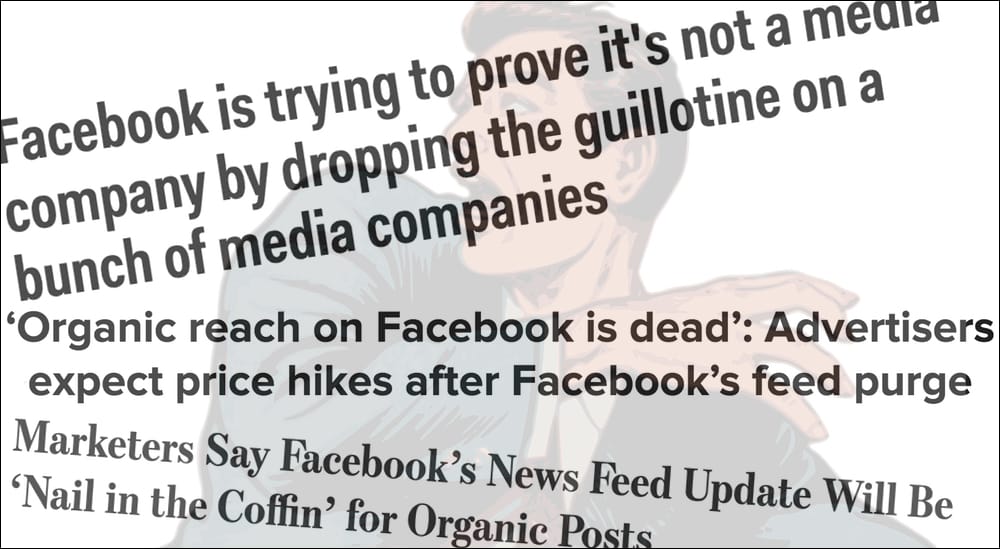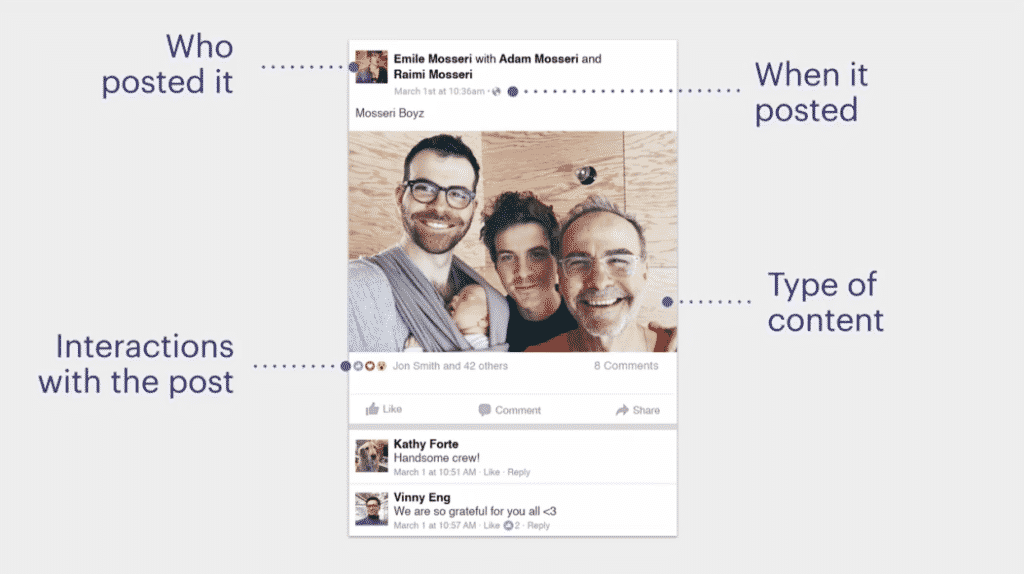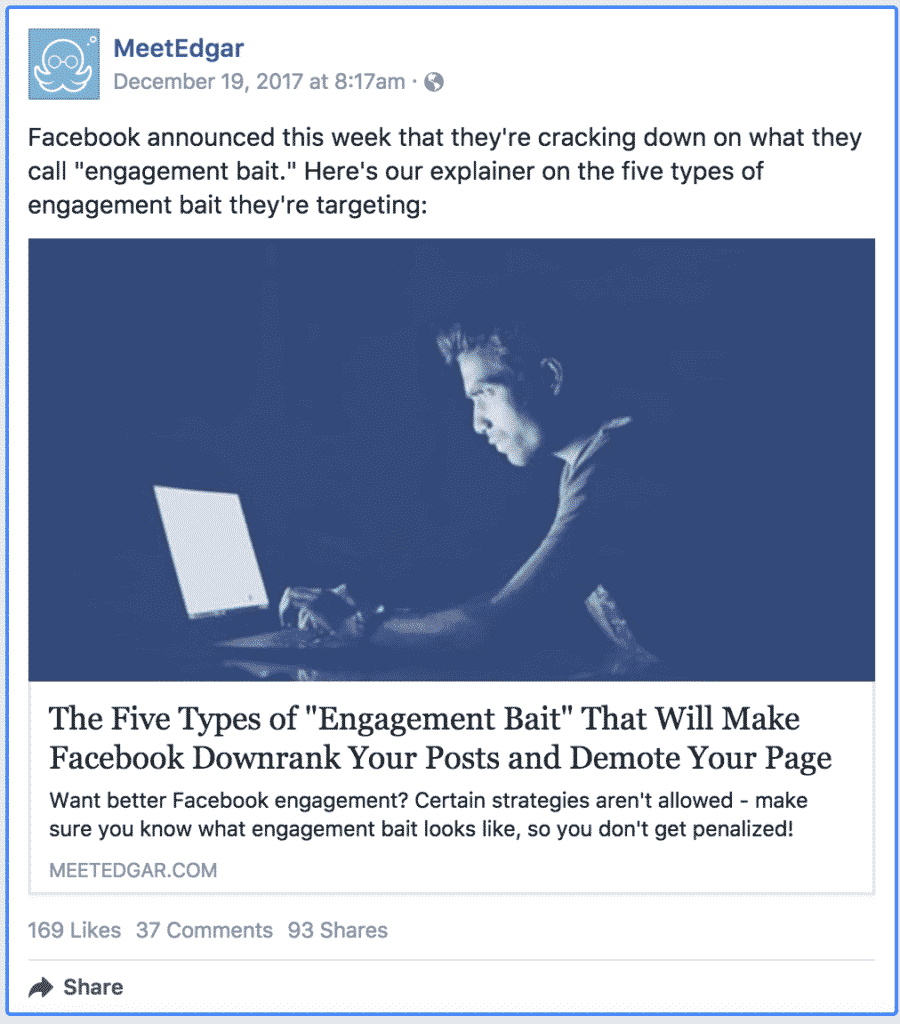Facebook kicked off 2018 by announcing some changes to how it determines what to show in the News Feed.
According to a lot of places, this was literally the scariest thing imaginable.
“Dropping the guillotine!”
“Organic reach on Facebook is dead!”
“Nail in the coffin for organic posts!”
Is this really the beginning of the end for brands on Facebook?
Well…no.
As much as we appreciate a juicy headline, this News Feed change doesn’t actually have to be that scary!
In fact, this update isn’t that different from MOST Facebook algorithm changes.
(We’ve got the receipts, too. Keep reading and you’ll see.)
So forget about the scary headlines, and stop stockpiling those freeze-dried Facebook likes in your panic room – let’s take a look at exactly what this update is, what it isn’t, and what you can actually DO about it!
Yes, Facebook is prioritizing friends and family over brands
Every time Facebook pushes an algorithm update, it changes what types of content people see in their News Feed. Certain types of content get higher priority, some get lower.
This is the type of content Facebook is going to prioritize:
- “Posts that spark conversations and meaningful interactions between people”
- “Posts that you might want to share and react to”
- “Posts from friends and family”
(Those are all straight from their news release, by the way.)
That last one is particularly important, because as Facebook describes, making posts from friends and family a higher priority means making posts from brands and media companies a lower priority.
That’s the part that leads to the scary headlines.
But here’s the thing:
Facebook has said this exact same thing before.
Like, the exact same thing.
In Summer 2016, Facebook announced that the News Feed algorithm would start prioritizing friends and family. They said that Pages for brands and media companies would probably get less organic reach and traffic. It was a whole thing – we even wrote a blog post about it!
Your relationship to an update’s source (that is, whether they’re a friend, family member, or brand that you follow) has always been a big deal – in fact, it’s one of the top four influences on whether you see an update at all. And Facebook has been prioritizing friends and family over brands for years.
This is just another step in the same direction Facebook has been moving for a long time – and it’s a step they’ve taken before!
Basically, Facebook’s “new” priorities for brands are exactly the same as their “old” ones: increasing engagement and authenticity.
Wanna keep up with these changes?
Here’s what that looks like for you.
How to play by Facebook’s “new” rules
So, quick recap:
– Facebook has a supposedly-new-but-not-actually-surprising focus on friends and family in the News Feed.
– Facebook ALSO wants to prioritize content that’s engaging and authentic.
This means that if you want to get noticed, you can’t share just any old content – you’ve gotta make it the kind of content Facebook prioritizes.
Or, as their news release puts it:
“Page posts that generate conversation between people will show higher in News Feed.”
You want to keep up with the changes? You’ve gotta get people clicking, sharing, and talking!
And if you want to share the types of content that are most reliable for that sort of thing, Facebook actually has some tips for you.
These are the types of content Facebook recommends for sparking conversations:
- Live videos (which Facebook says average 6x as many interactions as regular videos)
- Videos that explicitly prompt discussion (for example, by asking questions)
- Posts in Facebook Groups
- Posts especially relevant to local fans (for local businesses)
- News that starts conversations regarding important, timely issues
Here’s an example of that last one from our own Facebook Page:
On the one hand, this is a pretty simple update. It links to one of our blog posts, and it gives readers all the information they need in order to decide whether or not it’s relevant to their interests.
(In other words, it isn’t click bait. More on that in this post.)
Despite its simplicity, though, this update sparked conversation because of its topic – and updates that spark conversation are EXACTLY what Facebook wants to show higher in the News Feed.
Now, we know what you might be thinking:
“How can a post spark conversation if not many people see it?”
The most reliable method is to strategically pay to promote certain posts – and before your wallet starts quivering in fear, we’ll mention that this doesn’t mean paying to promote every post.
Take that update above as an example.
We chose an update we’d loaded and posted using Edgar – one that seemed like it had particularly high potential as a conversation-starter – and we paid literally just a few dollars to give it a boost in front of a specific audience.
The promotion was over almost as soon as it began, but in that short period of time, it had gotten a few people talking in the comments – and that momentum snowballed long after the promotion was over. The post had sparked conversations, so Facebook rewarded it with more and more organic reach.
(Paying early for a bit of momentum isn’t a new phenomenon in response to algorithm changes, either. Even in early 2016, Pages paid for nearly a third of their Facebook reach.)
Doing this for just SOME of your updates can help ALL of your updates score a bigger audience.
One of the methods Facebook uses for determining how many people see a Page’s update is to look at that Page’s overall success. When you post updates that perform well with users, Facebook predicts that your future updates will perform well, too, and wants to show those updates to even more people!
That’s why Facebook’s news release regarding the January 2018 update includes this particular gem:
“Pages making posts that people generally don’t react to or comment on could see the biggest decreases in distribution. Pages whose posts prompt conversations between friends will see less of an effect.”
The better your individual posts perform, the better you perform overall!
(Just be careful that you’re not prompting engagement by posting engagement bait – here’s an explainer on what that is, and how to avoid it.)
What’s your verdict on Facebook’s new update?
You’ve seen the scary headlines, and you’ve heard what Facebook actually has to say – so, what do you think?
Does this algorithm change look like more of the same, like that one from 2016?
Does it strike you as an unfair blow to brands and news publishers?
Or are you still just waiting for an algorithm change that’ll hide everything except videos of puppies seeing the sun for the first time?
Share your thoughts in the comments below!






11 Comments
Such good points! I reminded my clients that less organic reach is a loooong-coming trend. I love your tip to strategically boost posts to spark conversation, even for a few $.
Thanks, Eva! Yeah, we’ve definitely been surprised before by how even just a tiny amount of boost can go, when a post is compelling enough to build momentum from there.
But I love videos of puppies…
Don’t we all?
Well said!
I think it’s great for us creatives with smaller brand budgets. We’ve got to be more strategic and not simply post & promote for the sake of it.
Creating more thoughtful content is definitely always a good idea!
Soooo … what I was hoping for from this post was a little confidence boost on how using MeetEdgar will continue to be effective with the changing playing field. I *think* what you are saying is that MeetEdgar scheduled posts will have the same effect that they did before, i.e. it really depends on the amount of interaction produced by the post itself?
Exactly right! (And that’s good news!) Whether you’re using MeetEdgar or you’re posting natively, what matters most is that you’re posting quality updates. So like you said, using MeetEdgar will continue to be as effective as ever. This update is focused on the same thing as past updates: showing people the content they’ll be most interested in!
Great information. Thanks for writing this.
Thanks Geri!